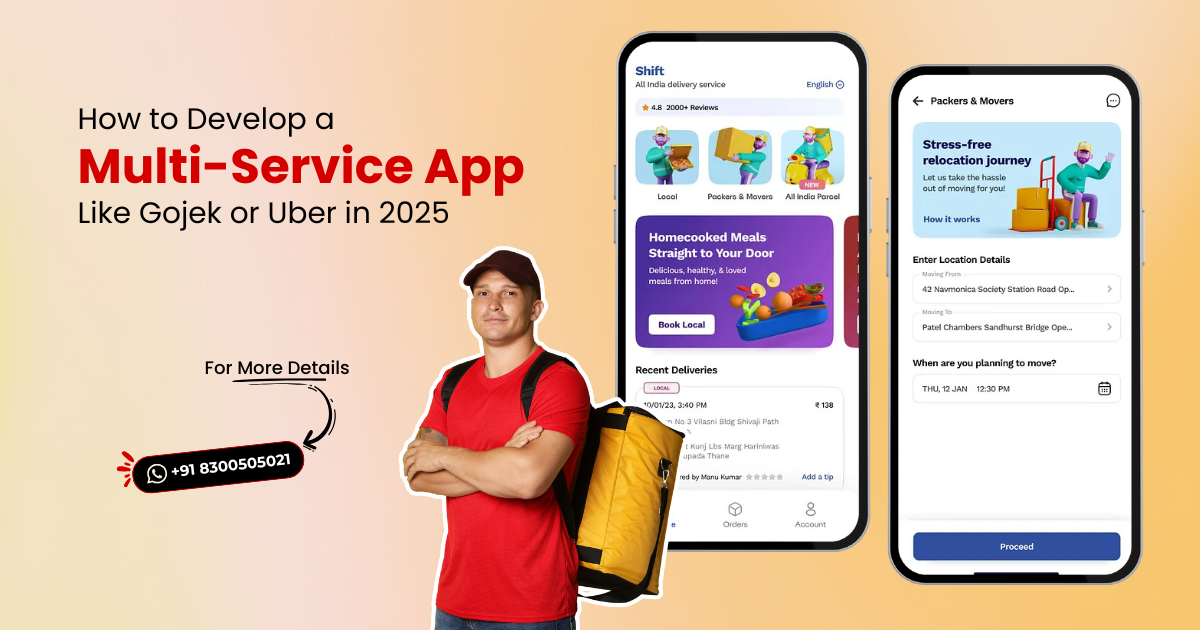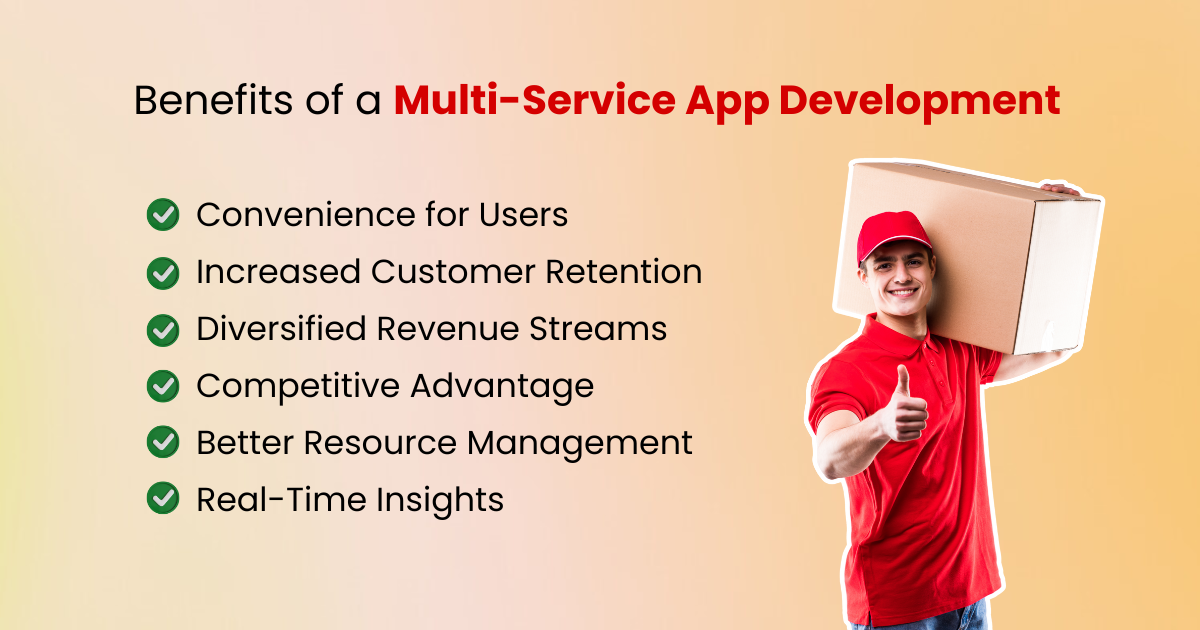The on-demand services industry is growing in the current situation and is searching for innovative and advanced solutions to meet consumer needs.
Apps like Gojek and Uber have transformed the way, ranging form transportation to food delivery, people book services, and even home services.
If you’re searching best solution for your business or want to enter this market. Multi-service app development is the best gateway to building a platform that gives huge revenue and a user experience.
In this guide, we’ll cover everything you need to know to develop a multi-service app in 2025, from planning and features to technology choices and monetization strategies.
What is a Multi-Service App?
A Multi-Service App is a single platform that supports users to access a variety of services ondemand. Unlike single-purpose apps, these service apps combine multiple services, like:
• Food delivery and grocery delivery
• Ride-hailing (taxi, carpooling, or auto-rickshaw)
• E-commerce and package delivery
• Home services (cleaning, plumbing, handyman tasks)
• Health and wellness services
Why Invest in Multi-Service App Development?
The benefits of developing an online booking script include:
📍Increased User Retention: Users stay on the app longer when multiple services are available in one place.
📍 Diversified Revenue Streams: You can earn from commissions, subscriptions, advertisements, and in-app purchases.
📍 Customer Experience: A single login and unified payment method improve convenience.
📍Competitive Advantage: A multi-service platform attracts a broader audience than single-service apps.
Key Features of a Multi-Service App
To build a successful app like Gojek or Uber, your platform must include essential features for different stakeholders. These features ensure smooth operations, user satisfaction, and business growth.
User App Features
🔹 Registration & Login: Users can quickly sign up using email, phone number, or social media accounts, ensuring easy access.
🔹 Service Selection: Clearly categorized services make it simple for users to find what they need without confusion.
🔹 Real-Time Tracking: Users can track rides, deliveries, or service providers on a live map, increasing transparency.
🔹 Payment Integration: Multiple secure payment options like wallets, cards, and UPI make transactions convenient.
🔹 Ratings & Reviews: Feedback helps users share experiences while improving service quality for future customers.
🔹 Push Notifications: Timely updates about bookings, promotions, or reminders keep users engaged with the app.
Service Provider App Features
🔹 Registration & Verification: Service providers upload documents for verification to maintain platform trustworthiness.
🔹 Service Requests: Providers can accept or reject tasks in real-time, giving them control over their schedule.
🔹 Earnings Dashboard: A dedicated dashboard shows completed tasks, total earnings, and payouts clearly.
🔹 Navigation & Route Optimization: Integrated maps help providers reach clients efficiently, saving time and fuel.
🔹 Ratings & Feedback: Providers can receive reviews from users to improve service quality and reliability.
Admin Panel Features
🔹 Dashboard Analytics: Admins get real-time insights into users, service demand, and revenue trends for informed decisions.
🔹 Service Management: Easily add, update, or remove service categories to keep the platform relevant.
🔹 User Management: Monitor and manage both users and service providers effectively for smooth operations.
🔹 Payment Management: Track all transactions, commissions, and payouts accurately for financial transparency.
🔹 Promotions & Discounts: Admins can run campaigns, special offers, or seasonal discounts to attract and retain users.
Benefits of a Multi-Service App Development
Developing a multi-service app offers numerous advantages for businesses, service providers, and users alike. Here are the key benefits:
1. Convenience for Users
Users can access multiple services in a single app, saving time and effort. They no longer need to download separate apps for rides, food, or home services.
2. Increased Customer Retention
Offering a variety of services keeps users engaged within the app, reducing churn and improving loyalty over time.
3. Diversified Revenue Streams
Businesses can earn from multiple sources—commissions, subscriptions, advertisements, and in-app purchases—making revenue more stable and scalable.
4. Better Resource Management
Service providers can manage requests, routes, and payments efficiently through the app, improving operational efficiency and reducing delays.
5. Competitive Advantage
A single platform offering multiple services positions your business as a convenient and comprehensive solution, attracting more users than single-service apps.
6. Real-Time Insights
Admins can monitor analytics like service demand, revenue, and user activity, helping make informed decisions to improve performance and growth.
Steps to Develop a Multi-Service App
Developing a multi-service app requires careful planning and execution. Here’s a step-by-step approach:
🔸 Market Research
• Analyze your target market and user demographics.
• Study competitors like Gojek, Uber, Grab, and DoorDash.
• Identify gaps in services that you can fill.
🔸 Define App Services
• Choose primary services to include initially (e.g., ride-hailing, food delivery).
• Plan for future expansions such as logistics, healthcare, or payments.
🔸 Decide on the App Model
• On-Demand Model: Real-time service requests with immediate fulfillment.
• Subscription Model: Users pay for a package of services.
• Hybrid Model: Combine real-time services with subscriptions for additional perks.
🔸 Choose the Technology Stack
Choose the best technologies to build a smooth and reliable app for your business. Ensure secure payments and real-time data management for seamless operations. Opt for efficient development to save time while keeping top performance.
🔸 UI/UX Design
• Design intuitive interfaces for all users.
• Ensure the app is fast, responsive, and easy to navigate.
• Include seamless onboarding and minimal steps to book a service.
🔸 Develop MVP (Minimum Viable Product)
• Launch a basic version with core features to test the market.
• Collect user feedback and improve app functionality.
• Avoid overloading the first release with too many services.
🔸 Testing
• Conduct functional testing, performance testing, and security testing.
• Ensure real-time tracking, payment processing, and push notifications work flawlessly.
• Use beta testers to gather real-world feedback.
🔸 Launch & Marketing
• Release the app on the Google Play Store and the Apple App Store.
• Implement marketing strategies like social media campaigns, influencer promotions, and referral programs.
• Offer launch discounts or perks to attract early adopters.
🔸 Post-Launch Maintenance
• Monitor app performance, user behavior, and feedback.
• Update the app regularly with new features and service categories.
• Ensure 24/7 customer support to resolve queries quickly.
Monetization Strategies
You can generate revenue through multiple streams:
💰 Commission on Services: Earn a percentage from each completed task.
💰 Subscription Plans: Offer a premium membership for added benefits.
💰 Advertisements: Promote partner brands within the app.
💰Surge Pricing: Charge extra during peak hours for certain services.
Challenges in Multiservice App Development
While multiservice apps offer significant opportunities, there are challenges to address:
📌 Complex Backend Architecture: Managing multiple services requires scalable backend systems.
📌 User Retention: Keeping users engaged with multiple services can be tricky.
📌 Payment Security: Secure transactions are critical to gain user trust.
📌 Regulatory Compliance: Depending on services offered, legal compliance may vary by region.
💰 How Much Does It Cost to Develop a Multi-Service App?
The cost of developing a Multi-Service app depends on factors such as features, design complexity, and the chosen platform. On average, it ranges from $30,000 to $100,000 for a fully functional MVP. The final price may vary based on customization, third-party integrations, and regional development rates.
⏱️ How Long Does It Take to Develop a Multi-Service App?
Typically, it takes 3–6 months to build a Minimum Viable Product (MVP) and around 6–12 months for a fully featured multi-service app with multiple integrated modules like ride-hailing, delivery, and home services.
🧩 Can I Add New Services After Launching the App?
Yes! Multi-service apps are designed to be highly scalable. You can easily add new services, categories, and features post-launch as your business grows or based on customer feedback and market demand.
🌟 How Can I Ensure My Multi-Service App Stands Out in the Market?
To make your app stand out, prioritize a smooth UI/UX, reliable service delivery, and real-time tracking. Strengthen customer loyalty with personalized offers, loyalty programs, or unique service bundles. Consistent app updates and responsive customer support also build long-term trust.
Final Thoughts
The on-demand services industry continues to grow in 2025, and a multiservice app is your ticket to tapping into this booming market. By combining convenience, scalability, and multiple revenue streams, your platform can attract a wide audience and generate sustainable growth.
With careful planning, smart technology choices, and a focus on user experience, you can develop an app like Gojek or Uber that stands out in today’s competitive landscape.




